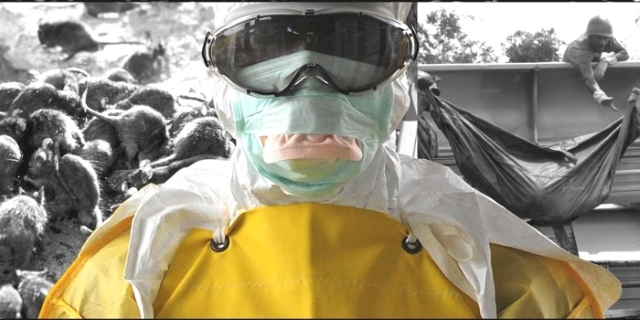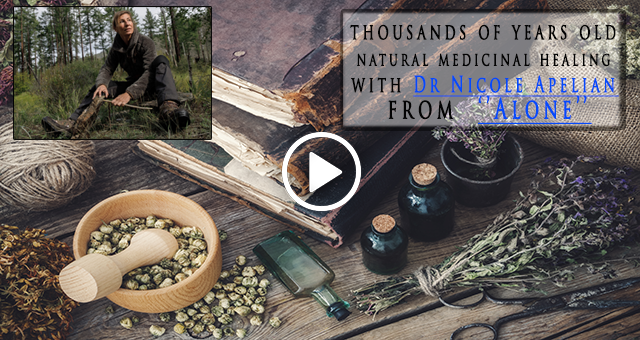
Why learn survival first aid and post-collapse medicine?
For the same reasons that today’s U.S. Army is experiencing lower fatality rates in battles in Iraq and Afghanistan. The new skills being taught to Army medics are allowing for swift medical evaluations and forward-deployed surgical teams. The most significant change has been the performance of medics and combat lifesavers in applying trauma care techniques. While we can’t pass on expert surgical procedures, we can pass on survival first aid medicine:
Because that is what you and I can turn to in a post-collapse environment, where there are no doctors, no surgeons, and no hospitals.
Our goal: Raise survival rates for those sick and injured in a land without 9-1-1.
Medical Emergencies In A Post-Collapse Environment
A lot of people — even those preparing for disaster — are unaware of how critical it is to have both medical supplies and first aid skills to deal with medical emergencies in a post-collapse or post-disaster environment.
Sure, you’re aware how necessary food and water are as a resource, but few people understand that one of the first things to be looted and literally turned into a killing zone are often the clinics, hospitals, veterinary clinics, pharmacies and anyplace where there is an availability of medicine or medical practitioners.
As a prepper, it is crucial to understand that hygiene, medical supplies and most of all medical skills are every bit as important as food and water in a post-disaster environment, which will quite likely be filled with rubble, disease, toxins, bacteria, physical danger and environmental injuries.
First (And Last) Aid
The first and most simple way to begin preparing yourself medically is to have some basic first aid supplies, be very familiar with where they are stored and be very comfortable using them. First aid courses — especially wilderness first aid courses, are a good place to get this type of training. The reason wilderness first aid courses are far more useful is that they generally are teaching skills to be used in a remote location where there is no higher medical care available. This is the type of medical situation you should be accustomed to working in.
The Mindset Of The Medic
One way to think about first aid in a post-disaster environment is what I call the “mindset of the medic“. This means that you are prepared to provide medical help and care for someone for the first few minutes after an injury, as well as the first few hours, the first few days and possibly the first few months. You must incorporate the full spectrum of medical care into your training. This means that first aid is also “last aid,” and is the kind of medical aid you are providing from start to finish for someone, no matter how long that might be.
Must-Know First Aid
Some of the most important and very basic life-saving procedures that will give you the greatest “bang for the buck” in wilderness first aid skills are:
How to treat major (or minor) blood loss from an open wound
- Know how to make a compression bandage, both with elastic wrap (like ACE wrap bandages) as well as with basic cloth (non-elastic)
- Know how to make a tourniquet with any kind of strap (cravat, belt, strip of cloth, etc.)
- Know how to inspect a wound for further damage such as tendons, nerve, etc., if the bleeding is not heavy enough to require immediate compression
How to treat a sucking chest wound
- Know how to check for an exit wound (especially in the case of a gunshot wound to the chest)
- Know how to apply a 3-sided and a 4-sided occlusive dressing
- Understand the signs and symptoms of a pneumo- and/or hemothorax (collapsing lung due to air or blood)
How to treat shock
- Understand the signs and symptoms of shock
- Understand the importance of keeping the injured person calm, warm, hydrated and secure
How to treat major infection
- Know how to identify infected tissue
- Know the signs and symptoms both locally (around a wound) as well as systemically (throughout the whole body)
- Know how to treat infection without being able to rely on antibiotics
How to treat a broken bone
- Understand how to identify a fracture of a bone
- Know how to splint and bandage fractures throughout the body such as fingers/toes, hand, wrist, arm, rib, collarbone, pelvis, thigh, lower leg, foot
How to treat dislocations
- Know how to identify and reduce (reset) a dislocation of the shoulder
- Understand how to identify a dislocation of the hip, elbow, finger, toe, knee
Some Basics To Survival First Aid
Actually going into how to treat all of the above injuries in a post-disaster environment would be well beyond the scope of an article of this size.
I am currently writing a wilderness herbal first responder (WHFR) manual to go with our WHFR course at The Human Path. It is the first book I know of that embraces both field medicine, sports medicine and in-depth herbal medicine from the standpoint of a clinical herbalist and former medic.
However, in this article I will go into a little bit of wilderness first aid depth on one subject. Let’s talk about lacerations, since that is a pretty common occurrence and is usually a minor to medium injury in a non-primitive environment, but can be a major concern in a post-disaster environment.
I like to say, “Treat every wound AS IF it were a life threatening one.” ASIF is a mnemonic to help you remember some basic laceration treatment:
- A = Amount of Bleeding or Blood Loss. Is this an arterial or a venous bleed? An arterial bleed will be a brighter red and usually pulsing or streaming out. If it is arterial, we must stop the bleed either using a compression bandage or a tourniquet. A compression bandage is easiest to create using an elastic wrap (like an ACE wrap) and a sterile gauze (one or more 4 x 4’s or Kerlix or some other type of sterile gauze). Place the gauze directly onto the laceration and apply pressure — or have the victim or a helper apply direct pressure. If possible, elevate the wound while you are doing this. Now wrap your elastic bandage around the gauze, wrapping from distal (closer to the fingers or toes) toward proximal (nearer to the heart) for the first set of wraps. This helps prevent pooling of venous blood in the extremity especially if the wrap is tight. To apply more pressure directly on the wound, don’t wrap more tightly. That will cut off circulation. Instead, turn the elastic wrap one half turn so that the wrap folds over itself right on top of the wound, and keep wrapping. You can repeat this every time you come around to the wound with the wrap.
- S = Shock. Where there is an injury of any severity, there will be some type of shock, even if psychogenic shock. Keep the victim reassured, calm, warm and as comfortable as possible. Don’t say meaningless things like, “everything’s going to be alright,” but allow your attitude to be strong and supportive. The more reassured the victim is that there is real help, the more his/her body can do what it needs to do most which is focus on healing without major adrenaline, psychological stress and other factors that will negatively affect their physiology of balance.
- I = Irrigate. If this is not a life-threatening arterial bleed and it is possible to get into the wound and wash it out, you must do so. In a post-disaster environment, anything that you get cut, stabbed or otherwise injured with is probably filthy. You must clean this wound if possible. As thoroughly and as quickly as possible.
- F = Functional or Further Damage. If you are able to irrigate this wound, this is the perfect time to inspect the wound for any type of functional damage. Were there tendons, nerves or major vessels cut? What does the damage look like? Can the victim move their fingers and/or toes or whatever is either distal or proximal to the wound? If there is functional damage to the area, then the treatment needs to include that, or at least recognize the issue. For example, if an extensor tendon was severed, there is no way to heal that without surgery. Or maybe if it was only nicked and you can see that, you know you need to keep the victim from extending that digit to let it heal.
What About Stitches?
It’s always exciting to think of stitching up a wound (suturing) for a lot of preppers. However, in a post-disaster, remote or primitive environment, suturing — at least for a wound that is simple enough for a layperson to suture — is highly irresponsible. It is unnecessary and will only create infection. Instead, leave it bandaged to stay as clean as possible, but let it heal without stitching. Steri-strips are fine. Tight bandaging is fine (within reason). Herbal poultices are great and will help reduce inflammation, pain and can increase tissue proliferation (healing). Suturing a wound in the field, on the other hand, is something to stay away from.
Infection
The biggest issue that you have to be aware of with an open wound in a post-disaster environment is infection. Dealing with infection is a matter of catching it as early as possible — which means knowing what to look for. All wounds will show some signs of inflammation, and also will have some degree of infection present. You have to monitor the wound, however, and determine between infection and inflammation. Here are some key points:
- Redness — Inflammation will create some redness, but infection will usually create more of it (more inflamed tissue area) and will often appear a brighter hue of red.
- Swelling — Inflammation will produce swelling as will infection. Swelling from infection is usually due to pus, however, produces a sharp pain if touched, and will drain.
- Pain — Inflammation will produce pain that is more “achey” while infection will produce a sharper pain, especially if it hurts while that part of the body is resting, or is an extremely sharp pain when moving it after remaining motionless for some time. The pain found with infection may be local to a specific area, or may be spread across a larger area than inflammation pain, which will generally be consistent around the wound area only.
- Pus (exudate) — Pus is a sign of infection, not inflammation.
- Fever — Fever is a serious sign of infection that is further along than you would ever want it to be in the field.
- Streaking — Red streaks that follow along veins, is a sign of serious infection.
Dealing With Infection
The classic orthodox treatment for infection is of course antibiotics? But what if you have no antibiotics? Or what if you don’t have the right kind? Or what if the infection is resistant to your antibiotics? Or what if you really don’t have the medical education to use antibiotics and recognize whether they are working, if there are allergic reactions, etc.?From any perspective, the first thing you must do to a wound (see above) is of course clean it. If an infection starts to take hold in the damaged tissue, the first thing you must do, once again, is clean it. The best and most efficient way to clean out infected tissue in an open wound is with activated charcoal. You can buy activated charcoal in capsule or tablet form, or just carry the powder in your first aid kit (we stock our herbal first aid kits with this as well) — which is how I do it. You can make activated charcoal as well, but the USP, food-grade activated charcoal is the most efficient and powerful effect you can get.
Using Charcoal
Make a paste with the charcoal and clean (preferably distilled) water. The charcoal forms a weak bond with water and will pick up anything else in the wound once it is in contact with it. It is a micro-sponge that will clean and adsorb toxins, bacteria and all of the dead tissue that is creating more food for bacterial growth. Mix the charcoal and water into a slurry or paste and put it in and around the wound directly. Place a sterile or clean gauze over the top and keep it in place with an elastic wrap or some other manner that works for you. You will see a change in the tissue state within hours, and should plan on changing out the charcoal poultice at least every few hours until the wound tissue no longer appears infected.
Antibacterial Herbs
There are many antibacterial herbs, and I use them in conjunction with tissue proliferative herbs in order to keep pathogenic bacterial growth at bay while working with a wound. I don’t usually use them until the wound is free from infection and the tissue looks good (inflamed, injured, but not infected). I do not put the herb directly into the wound generally, but make a poultice out of water and the powdered herb and fold it inside of sterile gauze (like a tea bag, except larger). It is important to use a lot of herb when doing this. Cover the wound area completely and then some. You want the mix of water and herb to drip into and around the wound to assist in wound healing and keep pathogenic bacteria from growing. Here are a few useful herbs for wound healing, anti-infective and anti-inflammation properties:
- Chapparal (Larrea tridentata) – Not only highly antibacterial, but also anti-inflammatory and an amazing tissue proliferative (increases wound healing).
- Myrrh (Commifera molmol) – Highly antibacterial, especially gram positive bacteria like strep and staph.
- Usnea (Usnea thallus) — A lichen that is also highly antibacterial. Necessary to pound or grind it enough to open up the outside layer of the strands and expose the inside.
- Oregon Grape (Berberis aquifolium) root or any of the Berberidiceae family such as Algerita, Barberry, etc. Also Goldenseal although that’s a different family. Very anti-microbial herb.
- Plantain (Plantago spp.) – Great tissue healing (proliferative) herb and also has anti-bacterial components (baicalin) that help inhibit the formation of gram positive bacterial bio-films. Makes this an excellent “helper herb” in a formula.
- Cone Flower (Echinacea spp.) – Very effective topically on toxic wounds especially — when there is toxin from poisonous insects, reptiles or dead tissue involved.
Lymph Movers
Along with external poultices and tissue care, it is also necessary to take herbs internally in order to help the immune system deal with an infection, as well as promote healing. Here are a few herbs that help stimulate the immune system, the lymph, and help tissue heal:
- Poke (Phytolacca americana) root — this is a very potent herb and should be used in a formula and with care. However, it is a highly effective lymph stimulator and lymph mover to assist the body in dealing with infection.
- Cone Flower (Echinacea spp.) – Echinacea stimulates white blood cell (WBC) creation and activity.
- Boneset (Eupatorium perfoliatum) — Boneset also greatly increases WBC counts. Arguably better than Echinacea, even, and that’s saying a lot.
- Gotu Kola (Centella asiatica) — Gotu Kola is an amazing tissue proliferative whether taken internally or applied externally. This herb will increase the speed of tissue healing.
- Self Heal Spike (Prunella vulgaris) — Increases the speed of endothelial tissue healing in damaged blood vessels and capillaries while lowering inflammation, thereby increasing circulation to the wound area and speeding healing.
- Bilberry (Vaccinium myrtilis) — Increases microcirculation in the wound area and speeds healing as well as keeping the area clean and infection free.
Final Note
In conclusion, understand that skills are generally more important than supplies when it comes to post-disaster medicine. Most importantly, skills are more important than supplies when it comes to herbal first aid. Being able to identify and use medicinal plants is knowledge that means you never have to be without medicine. Plus, this is a skill you can start learning immediately. It may be a lifetime of learning, but you can do so without having to change your life (i.e. go to med school, etc.). Check out my online Herbal Medic Level 1 course if you’d like to get started with a practical, inexpensive yet in-depth exploration into field medicine using plants.
When the power goes out, your safety and comfort is important.
Protect your home or business with a new fully automatic standby generator. Maintain your security system, lighting and air conditioning to keep your family or business safe and comfortable through any power outage
Enjoy the total peace of mind that comes with knowing you have a constant and reliable power supply for your home or business in with a standby generator from Alternate Power Solutions. From everyday necessities like heating, cooling, refrigeration and lights, to daily essentials like cooking, laundry or kids bath times. Power outages are occurring more frequently than ever and lasting longer with devastating effects.
Stand up to unpredictable weather and unforeseen outages with the most trusted name in residential standby power with backup generators for homes. If the power ever goes out, your General standby generator goes on – automatically – protecting you and your home 24/7.

Books can be your best pre-collapse investment.
Carnivore’s Bible (is a wellknown meat processor providing custom meat processing services locally andacross the state of Montana and more. Whether your needs are for domestic meator wild game meat processing)
The Lost Book of Remedies PDF ( contains a series of medicinal andherbal recipes to make home made remedies from medicinal plants and herbs.Chromic diseases and maladies can be overcome by taking the remediesoutlined in this book. The writer claims that his grandfather was taughtherbalism and healing whilst in active service during world war twoand that he has treated many soldiers with his home made cures. )
Easy Cellar(Info about building and managing your root cellar, plus printable plans. The book on building and using root cellars – The Complete Root Cellar Book.)
The Lost Ways (Learn the long forgotten secrets that helped our forefathers survive famines,wars,economic crisis and anything else life threw at them)
LOST WAYS 2 ( Wordof the day: Prepare! And do it the old fashion way, like our fore-fathers did it and succeed longbefore us,because what lies ahead of us will require all the help we can get. Watch this video and learn the 3 skills that ensured our ancestors survival in hard times offamine and war.)
Survival MD (Best Post Collapse First Aid Survival Guide Ever)
Conquering the coming collapse (Financial advice and preparedness )
Liberty Generator (Build and make your own energy source)
Backyard Liberty (Easy and cheap DIY Aquaponic system to grow your organic and living food bank)
Bullet Proof Home (A Prepper’s Guide in Safeguarding a Home )
Family Self Defense (Best Self Defense Strategies For You And Your Family)
Survive Any Crisis (Best Items To Hoard For A Long Term Crisis)
Survive The End Days(Biggest Cover Up Of Our President)
Drought USA(Discover The Amazing Device That Turns Air Into Water)


